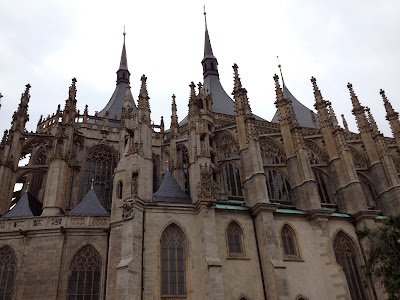Kutná Hora
Chrám svaté Barbory (Saint Barbara's Church) in Kutná Hora is one of the most famous Gothic churches in central Europe and it is a UNESCO world heritage site. St Barbara is the patron saint of miners (among others), which was highly appropriate for a town whose wealth was based entirely upon its silver mines.Work on the monumental church of St Barbara began in the 1380s. In 1558 the cathedral was completed with the construction of the facade and three tent roofs.
Medieval frescoes depicting the secular life of the medieval mining town and religious themes have been partially preserved.
More info:
http://whc.unesco.org/en/list/732
http://en.wikipedia.org/wiki/St._Barbara%27s_Church,_Kutn%C3%A1_Hora
http://www.kutna-hora.net/en/barbara.php/
Kostnice v Sedlci (Sedlec Ossuary)
Kostnice v Sedlci (The Sedlec Ossuary) is a small Roman Catholic chapel, located beneath the Cemetery Church of All Saints (Czech: Hrbitovní kostel Všech Svatých) in Sedlec, a suburb of Kutná Hora in the Czech Republic. The ossuary is estimated to contain the skeletons of between 40,000 and 70,000 people, whose bones have in many cases been artistically arranged to form decorations and furnishings for the chapel. The ossuary is among the most visited tourist attractions of the Czech Republic, attracting over 200,000 visitors yearly.Four enormous bell-shaped mounds occupy the corners of the chapel. An enormous chandelier of bones, which contains at least one of every bone in the human body, hangs from the center of the nave with garlands of skulls draping the vault. Other works include piers and monstrances flanking the altar, a large Schwarzenberg coat of arms, and the signature of Rint, also executed in bone, on the wall near the entrance.
In 1278, Henry, the abbot of the Cistercian monastery in Sedlec, was sent to the Holy Land by King Otakar II of Bohemia. He returned with a small amount of earth he had removed from Golgotha and sprinkled it over the abbey cemetery. The word of this pious act soon spread and the cemetery in Sedlec became a desirable burial site throughout Central Europe.
In the mid 14th century, during the Black Death, and after the Hussite Wars in the early 15th century, many thousands were buried in the abbey cemetery, so it had to be greatly enlarged.
Around 1400, a Gothic church was built in the center of the cemetery with a vaulted upper level and a lower chapel to be used as an ossuary for the mass graves unearthed during construction, or simply slated for demolition to make room for new burials.
After 1511, the task of exhuming skeletons and stacking their bones in the chapel was given to a half-blind monk of the order.
Between 1703 and 1710, a new entrance was constructed to support the front wall, which was leaning outward, and the upper chapel was rebuilt. This work, in the Czech Baroque style, was designed by Jan Santini Aichel.
In 1870, František Rint, a woodcarver, was employed by the Schwarzenberg family to put the bone heaps into order, yielding a macabre result.
Rychov nad Kněžnou
Great attempts were made to keep off the main highways as we went from place to place. This is a good example of the roads we used. If we did meet another vehicle, it was necessary to slow down and carefully navigate the shoulders of the road, if there were any.Rychov nad Kněžnou had been the village my group was assigned to explore for our “Language Independence Day” at Dobruška, so there are more photos of the town on that posting from 2009.
Bylo nás pět, sousoší v Rychnově nad Kněžnou
"It was five of us" sculpture in Rychnově nad Kněžnou
Bylo nás pět je humoristický román Karla Poláčka, ve kterém autor vzpomíná na své dětství v Rychnově nad Kněžnou. Vypravěčem a zároveň hlavním hrdinou je školák Petr Bajza. Kniha je poměrně volným sledem jednotlivých příhod a dobrodružství, jež potkávají vypravěče a jeho čtyři kamarády: Čeňka Jirsáka, Antonína Bejvala, Edu Kemlinka a Pepka Zilvara z chudobince (chudobinec je kolektivní charitativní ubytování pro chudé). Román napsal Poláček krátce před odchodem do Terezína v roce 1943, poprvé vyšel rok po druhé světové válce. Roku 1995 bylo dílo zfilmováno jako stejnojmenný šestidílný televizní seriál.
It was five of us is a comic novel by Karel Polacek, in which the author recalls his childhood in Rychov nad Kněžnou. The narrator and main character is schoolboy Peter Bajza. The book is a relatively free sequence of events and adventures had by the narrator and his four friends: Čeněk Jirsák, Anthony Bejvala, Edu Kemlink and Pepka Zilvar from the poorhouse. Polacek wrote the novel shortly before going to Terezin in 1943. It was first published a year after the Second World War. In 1995 the work was filmed as a six-part television series of the same name. An English translation called "We Were a Handful" was published in 2007 by Karolinum Press, Charles University, ISBN-13: 978-8024614496.
From Frank: I read the English translation of this book mentioned about. I really wanted to like it because of the author's life story and that he had written this as a lighthearted book in a difficult time in Czech history. But I had a hard time getting into the story. Perhaps the Czech version was written in the schoolboy slang of the era when it was written? The translation appears to use British schoolboy slang of about the same time period, which I found kept me at a distance from the characters. There was also very little emotion conveyed about the things happening in the story - which kept me from caring.
Price for a
nice modest home 3,500,000 Kč (about $175,000).
More coming soon.

























































No comments:
Post a Comment